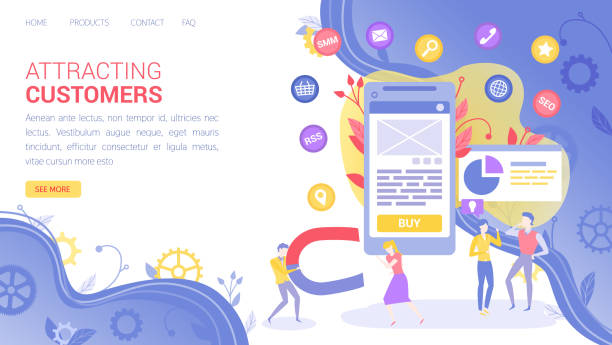Introduction to Secure Website Design and Its Importance

In today’s digital world, where we witness the unprecedented expansion of online presence for businesses and individuals every day, the topic of #Secure_Website_Design is of vital importance.
A website, regardless of its size or field of activity, can be targeted by numerous cyber attacks that not only lead to the loss of sensitive data and users’ personal information but can also severely damage the business’s credibility and revenue.
Therefore, secure website design is no longer an option but an undeniable necessity.
Security must be an integral part of the website design and development process from the very initial stages, not an afterthought.
Ignoring security principles can lead to #data_breaches, loss of customer trust, and even heavy legal fines.
Today, awareness of web threats and vulnerabilities and adopting preventive approaches are the cornerstone of any successful secure website design.
This article provides an explanatory and guiding review of various aspects of secure website design and offers practical solutions to increase your site’s resistance to cyber attacks.
We aim to provide a comprehensive and educational perspective in this area so that developers, web administrators, and even ordinary users can contribute to building a safer environment for online interactions by better understanding the challenges and solutions.
This concept encompasses all aspects, from coding to server configuration and user training.
Is your company’s website performing as it deserves for your brand? In today’s competitive world, your website is your most important online tool. Rasawab, a specialist in professional corporate website design, helps you to:
✅ Gain customer credibility and trust
✅ Convert website visitors into customers
⚡ Get a free consultation!
Common Web Threats and Fundamental Vulnerabilities

To achieve a secure website design, a precise understanding of common web threats and vulnerabilities is essential.
Cyber attacks are becoming more complex day by day and can infiltrate a website through various means.
One of the best-known and most dangerous of these attacks is SQL Injection, which allows an attacker to manipulate the database or steal sensitive information by injecting malicious SQL code into website inputs.
Another very common attack is Cross-Site Scripting (XSS), in which the attacker injects malicious JavaScript code into web pages, and users’ browsers execute it, which can lead to cookie theft or alteration of page content.
In addition to these, Cross-Site Request Forgery (CSRF), DDoS (Distributed Denial of Service) attacks, and vulnerabilities related to broken authentication are also among the main threats.
DDoS attacks cause service disruption by sending a massive volume of traffic to the server, while broken authentication allows attackers to gain access to user accounts by bypassing login systems.
An analytical and specialized understanding of these vulnerabilities is the first step in adopting correct approaches for a secure website design.
Developers and administrators must constantly be familiar with the latest vulnerability lists, such as the OWASP Top 10, to implement effective preventive measures.
Principles of Secure Coding and Best Practices

The foundation of any secure website design is secure coding.
This stage is where developers can prevent many vulnerabilities by adopting correct approaches.
One of the most important principles is input validation.
All inputs received from users, whether form fields, URL parameters, or HTTP headers, must be carefully validated and filtered.
This prevents attacks such as SQL Injection and XSS.
For example, instead of directly concatenating user input into SQL queries, Parameterized Queries or Prepared Statements should be used.
Another principle is proper output encoding.
Any data retrieved from the database and intended to be displayed to the user on the web page must be properly encoded to prevent XSS attacks.
Using modern web development frameworks that inherently support many of these security principles can greatly assist in secure website design.
Also, the Principle of Least Privilege should be considered; meaning that each part of the application or each user should only have access to the minimum resources and operations required.
This specialized and educational approach to coding plays a central role in the security robustness of a website.
| Practice | Description |
|---|---|
| Input Validation | Ensuring user inputs match the expected format and data type and removing malicious characters. |
| Parameterized Queries | Using this method to prevent SQL Injection and separate commands from data. |
| Output Encoding | Encoding data displayed to the user to prevent XSS attacks. |
| Proper Error Handling | Not displaying technical error details to the user, which could provide information to an attacker. |
| Use of Secure Frameworks | Utilizing frameworks and libraries that have built-in security features. |
Database Security: The Heart of Secure Website Design

The database is the beating heart of any dynamic website and contains the most valuable information, including users’ personal information, financial data, and site content.
Therefore, database security is one of the most vital pillars in secure website design.
The first step in securing a database is using strong and complex passwords for database user accounts.
These passwords should not be default and must be changed regularly.
Furthermore, strict access management to the database is of high importance.
Each user or service should only have the minimum necessary privileges to perform its tasks (Principle of Least Privilege).
For example, users who only need to read information should not have write or delete access.
Data encryption, both at rest (Data at Rest) and in transit (Data in Transit), also adds a powerful security layer.
Encrypting sensitive information stored on disk and using secure protocols like SSL/TLS for communication between the web server and the database prevents eavesdropping and data manipulation.
Regular and secure backups of the database and storing them in a safe, separate location are also essential for data recovery in case of any incident.
These specialized approaches and guidelines are key to preventing information leaks and maintaining a secure and reliable website design.
Are you worried about your e-commerce site’s low conversion rate and not getting the sales you desire?
Rasawab, your specialized solution for a successful e-commerce site.
✅ Significant increase in conversion rate and sales
✅ Professional and user-friendly design to attract customer satisfaction
⚡ Ready for a transformation in online sales? Get a free consultation!
Server and Infrastructure Protection

Secure website design is not limited to coding; server and hosting infrastructure security is equally vital.
Servers have multiple entry points for attackers, and their incorrect configuration can lead to serious vulnerabilities.
One of the initial measures is Server Hardening, which includes disabling unnecessary services, removing default and unused software, and closing unnecessary ports.
The smaller the attack surface, the lower the probability of infiltration.
Regular updates of the operating system and all installed software (such as web server, database, and programming languages) to apply new security patches are of high importance.
Attackers often exploit known vulnerabilities in older versions of software.
Firewalls, both software and hardware, play a crucial role in controlling inbound and outbound traffic and blocking unauthorized access.
Using a Content Delivery Network (CDN) can also help protect against DDoS attacks and improve website performance.
Using SSL/TLS certificates to encrypt communications between the user’s browser and the server not only ensures data security but also helps with SEO and is an integral part of modern secure website design.
These explanatory and specialized measures create powerful defensive layers for the website’s infrastructure.
User Authentication and Access Management

One of the sensitive points in any secure website design is how user identity and access are managed.
Strong authentication systems are the first line of defense against unauthorized access.
Implementing strong password policies that compel users to use complex combinations of letters, numbers, and symbols is essential.
Also, storing user passwords should be in a hashed form, using strong algorithms and with Salt, so that even if the database is breached, passwords are not easily recoverable.
Multi-Factor Authentication (MFA) adds a significant security layer; by enabling MFA, even if an attacker knows the user’s password, they will need a second factor (such as an SMS code or an authenticator app) to access the account.
Secure Session Management is also vital.
Sessions should have appropriate expiration times, session cookies must be set securely (HttpOnly, Secure flags), and session tokens should be generated randomly and unpredictably.
Role-Based Access Control (RBAC) systems, where each user only has access to the resources and functions their role dictates, provide important guidance for reducing the attack surface and strengthening secure website design.
These educational and guiding approaches form the backbone of user account security.
Countering Common Attacks and Advanced Protection

After understanding threats and implementing secure coding and infrastructure principles, the next step in secure website design is to focus on advanced mechanisms for countering common attacks.
To combat SQL Injection, in addition to using Parameterized Queries, which was mentioned earlier, a Web Application Firewall (WAF) can be used.
WAFs can analyze incoming traffic and identify and block attack patterns even before they reach the web server.
Regarding XSS attacks, in addition to proper output encoding, implementing a Content Security Policy (CSP) offers powerful defense.
CSP instructs the user’s browser on what resources (scripts, stylesheets, images) can be loaded from where, thereby preventing the execution of malicious scripts from unauthorized sources.
To counter CSRF, it is essential to use CSRF tokens that are unique for each form request and validated on the server side.
Furthermore, Intrusion Detection Systems (IDS) and Intrusion Prevention Systems (IPS) help to continuously monitor network traffic and identify and prevent suspicious activities.
These analytical and specialized approaches for a secure website design significantly strengthen defensive layers and enhance the ability to detect and respond to threats.
| Attack Type | Counter Strategy |
|---|---|
| SQL Injection | Parameterized Queries, Input Validation, WAF |
| Cross-Site Scripting (XSS) | Output Encoding, Content Security Policy (CSP), Input Validation |
| Cross-Site Request Forgery (CSRF) | CSRF Tokens, Referrer Header Check |
| Distributed Denial of Service (DDoS) | Use of CDN, Rate Limiting, Layer 7 Firewalls |
| Broken Authentication | Multi-Factor Authentication (MFA), Strong Password Policy, Secure Session Management |
Security Auditing, Updates, and Incident Response

Even with the best secure website design approaches, websites must be regularly reviewed for security.
The world of cyber threats is constantly evolving, and what is secure today may be vulnerable tomorrow.
Regular security audits, such as Penetration Testing and Vulnerability Scanning, are vital for identifying weaknesses before attackers discover them.
Penetration testing involves simulating real attacks by security professionals to discover and resolve potential weaknesses.
Regular software updates, including the operating system, web server, database, and all used libraries and frameworks, are essential for applying security patches and addressing known vulnerabilities.
Neglecting these updates can leave a website vulnerable to easy attacks.
Furthermore, having an Incident Response Plan is crucial for any organization or individual with a website.
This plan should include specific steps for identification, containment, eradication, recovery, and lessons learned in the event of a security incident.
These guiding and informative measures provide a proactive and reactive approach to maintaining a stable and secure website design.
Are you missing business opportunities because of an outdated website? With Rasawab, solve the problem of not attracting potential customers through your website forever!
✅ Attract more quality leads
✅ Increase brand credibility in the eyes of customers
⚡ Get a free corporate website design consultation!
The Role of the Human Factor in Web Security

Secure website design goes beyond code and configuration; the human factor also plays a very important role in the overall security of a system.
Even the most secure systems can be compromised through social engineering or phishing.
Social engineering refers to a set of techniques where an attacker uses deception and psychological manipulation to coerce individuals into revealing sensitive information or performing actions that benefit the attacker.
Phishing attacks, where fake emails or messages are designed to steal login credentials, are a common example of these types of attacks.
To combat these threats, educating and raising awareness among users and developers is of high importance.
Users should be trained on the importance of using strong passwords, identifying phishing emails, and adhering to basic online security principles.
Developers must also stay continuously updated with the latest vulnerabilities and best secure coding practices.
Organizing training courses and awareness campaigns can help create a strong security culture within an organization.
This entertaining and thought-provoking content demonstrates that security is a comprehensive process that encompasses all aspects, from technology to human behavior, and ultimately, the human factor can be the strongest or weakest link in the secure website design chain.
The Future of Web Security and Leading Trends

The world of web security is constantly changing and evolving, and with the emergence of new technologies, threats also become more complex.
Therefore, to maintain a secure website design in the future, leading trends and emerging threats must be considered.
One important trend is the increasing use of Artificial Intelligence (AI) in cyber attacks and cyber defense.
Attackers can use AI to automate and target attacks, while security professionals leverage it for faster detection of malicious patterns and automated responses to threats.
The Zero Trust Architecture is also emerging as a new security model built on the principle that no user, device, or application, whether inside or outside the network, is trustworthy by default.
All requests must be continuously authenticated and authorized.
Integrating DevSecOps, meaning incorporating security considerations into all stages of the Software Development Life Cycle (SDLC), from initial design to deployment and maintenance, is also a critical approach.
This analytical and explanatory approach shows that secure website design is a continuous process, not a final destination.
Teams must continuously learn, adapt, and implement best practices to combat the changing threat landscape and make their websites resilient against future challenges.
Frequently Asked Questions
| Row | Question | Answer |
|---|---|---|
| 1 | What is secure website design? | The process of designing and developing websites that are resistant to cyber attacks and protect user data and privacy. |
| 2 | Why is website security important? | To prevent data breaches, financial losses, damage to company reputation, and maintain user trust. |
| 3 | What are some common website security threats? | SQL Injection, XSS (Cross-Site Scripting), CSRF (Cross-Site Request Forgery), weak authentication, and unpatched software. |
| 4 | What is SSL/TLS and what is its role? | Protocols for encrypting data between the user’s browser and the website server, ensuring secure and private communication. |
| 5 | How can SQL Injection attacks be prevented? | By using Prepared Statements/Parameterized Queries, input validation, and ORMs (Object-Relational Mappers). |
| 6 | What is the role of a Web Application Firewall (WAF) in security? | A WAF monitors and filters HTTP traffic between a web application and the internet to prevent malicious attacks. |
| 7 | Why are regular updates of software and libraries essential? | Updates include patches for known security vulnerabilities that attackers can exploit. |
| 8 | How can XSS attacks be prevented? | By sanitizing (Sanitizing) and escaping (Escaping) all user inputs before displaying them on the web page and using Content Security Policy (CSP). |
| 9 | What does the Principle of Least Privilege mean? | It means that users and systems are granted only the minimum necessary permissions to perform their tasks, preventing unnecessary access to resources. |
| 10 | What is the importance of proper user session management? | To prevent session hijacking and unauthorized access to user accounts through secure and expiring session tokens. |
And other services of Rasawab Advertising Agency in the field of advertising
Smart Social Media: Designed for businesses seeking campaign management through precise audience targeting.
Smart Content Strategy: Transform click-through rates with attractive UI design.
Smart Digital Advertising: Professional optimization to improve SEO ranking using intelligent data analysis.
Smart SEO: A fast and efficient solution to increase website traffic with a focus on attractive UI design.
Smart SEO: A fast and efficient solution for online growth with a focus on precise audience targeting.
And over hundreds of other services in the field of internet advertising, advertising consultation, and organizational solutions
Internet Advertising | Advertising Strategy | Advertorials
Resources
Principles of Secure Site DesignWebsite Security TipsBest Practices for Web SecurityComprehensive Web Security Guide
? On the path to your business growth and transformation, Rasawab Digital Marketing Agency, with years of experience and specialized knowledge, is your partner. With us, you not only experience optimization and a powerful online presence, but with our professional services in fast website design, we create your digital identity in the shortest time and with the highest quality. Let us build your online success!
📍 Tehran, Mirdamad Street, next to Bank Markazi, Kazerun Jonubi Alley, Ramin Alley, Plaque 6

